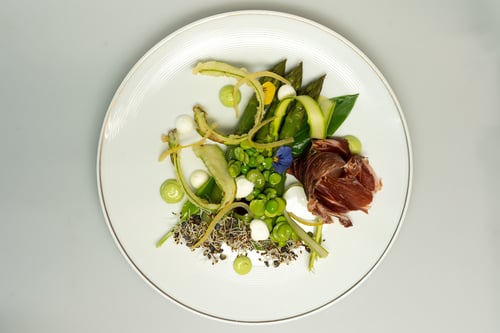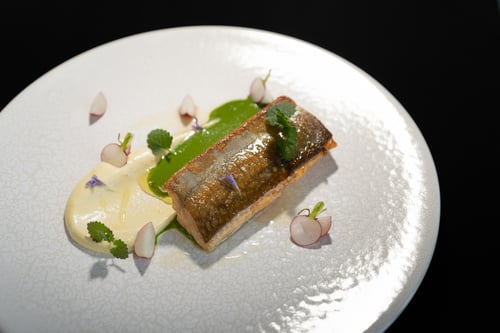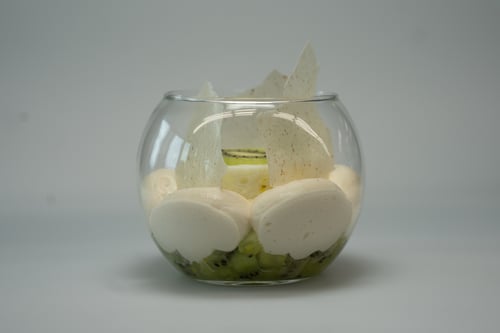Summer Menu
Ingredients for 4 people
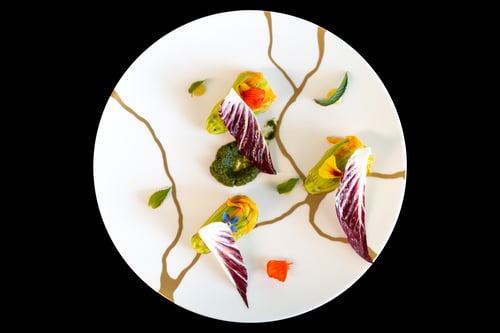
For the stuffed zucchini flowers
• 12 zucchini flowers
• ½ shallot (12g)
• ½ slice country ham (24g)
• 12 peeled Swiss shrimps (240g)
• 20g sourdough bread
• 15g double cream
• 1 tablespoon calamansi vinegar
For the Kimchi
• 200g Kimchi
• 20g parsley
For dressing
• Agastache and peppermint leaves, borage and nasturtium flowers
Preparation
Soak the bread, cut into 5mm cubes, in the double cream. Chop half a shallot. Cut ham and shrimps into 5mm cubes. Mix all the ingredients together, then stuff the zucchini flowers.
Steam the stuffed zucchini flowers for 5 min.
Blend Kimchi with parsley until smooth.
Dressing
1. Place Kimchi pomade and 3 stuffed zucchini flowers on a flat plate.
2. Garnish as desired with agastache and peppermint leaves, as well as borage and nasturtium flowers.
Ingredients for 4 people
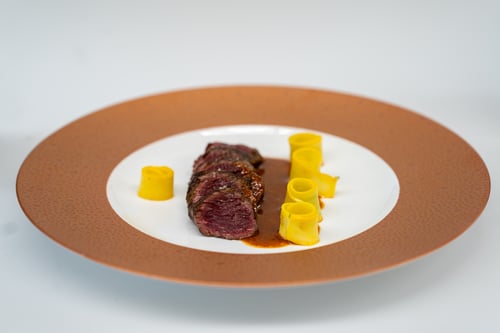
For the marinade
• 16g soy sauce
• 40g olive oil
• 16g lemon juice
• 8g Worcestershire sauce
• 1 garlic clove
• 8 basil leaves
• 8 leaves flat-leaf parsley
• 4g paprika
• 1g ichimi togarashi (Japanese chili pepper)
• 1.6g salt
For the meat
• 360g beef onglet
For the sauce
• 250g beef jus
For the side dish
• 200g zucchini
Preparation
Grate the garlic clove. Mix all the ingredients and marinate the meat for at least one night in the fridge. If possible, vacuum-seal for 5 days in the fridge.
Remove the meat and chill the marinade. Sear the meat on the BBQ for 5 minutes on each side.
Add the marinade to beef stock and reduce gently.
Cut zucchini into strips. Blanch in boiling water for 2 min.
Presentation
On a flat plate, dress according to your desire.
Ingredients for 4 people
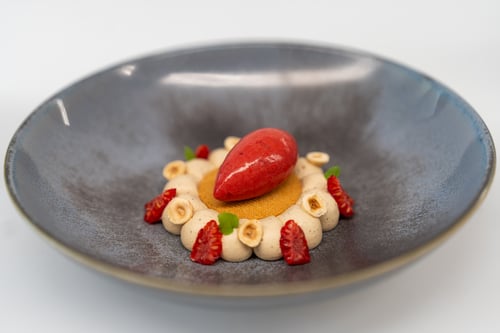
For the coffee Chantilly
• 80g liquid cream (min. 30% fat)
• 8g coffee beans
• 7g sugar
• 8g mascarpone
For the hazelnut crunch
• 40g hazelnut purée
• 24g feuilletine (crumbled crispy crêpes)
• 8g chocolate
For the hazelnut cookie
• 32g egg white
• 24g sugar
• 20g hazelnut powder
• 6g corn flour
• 4g powdered sugar
• 1 pinch salt
For the hazelnut shortbread
• 72g flour
• 22g potato starch
• 40g butter
• 36g powdered sugar
• 12g hazelnut powder
• 22g whole egg
• 1 pinch salt
For the raspberry sorbet
• 75g water
• 30g sugar
• 120g raspberry
For the dressing
• 12 hazelnuts
• 12 raspberries
Preparation
Pre-brew the cream and coffee beans for 24 hours. Strain through a fine sieve. Mix the infused cream with the mascarpone, then whip up the Chantilly by adding the caster sugar.
Melt the chocolate in a bain-marie, then mix with the hazelnut purée. Add the broken feuilletine to obtain the hazelnut crunch.
Preheat oven to 200°C. Beat the egg whites until stiff, adding the salt and caster sugar in two batches. Lastly, add the sifted hazelnut powder, corn flour and powdered sugar. Spread the mixture thinly on 1 silicone baking sheet. Bake for 15min. Cut out with a cookie cutter after baking.
Preheat oven to 175°C. Mix flour, potato starch, sugar, hazelnut powder and salt. Combine the flour and the diced butter until crumbly. Add the egg and mix until the dough comes together without being too wet. Leave to rest for 1 hour. Spread the mixture thinly on 1 silicone baking sheet. Cut out with a cookie cutter before baking. Bake the hazelnut shortbread for 20min.
Freeze the raspberries in advance. Blend the frozen raspberries with the sugar and water at refrigerator temperature (3-5°C). Form into quenelles and serve immediately.
Dressing
1. In a soup plate, place the hazelnut cookie, add the hazelnut crunch and finally the hazelnut shortbread.
2. Decorate with the coffee Chantilly.
3. Add the halved hazelnuts and raspberries.
4. Finish with a quenelle of raspberry sorbet.

